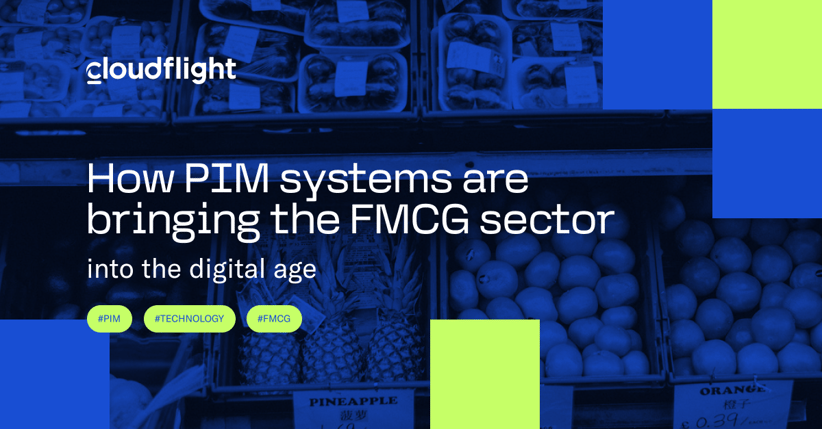Fast-moving consumer goods (FMCG) is one of the most challenging commerce sectors to operate in. Fierce competition, razor-thin margins on products, the complexity of the supply chain, and the push toward sustainability are just a few of the headaches that businesses in the sector need to manage.
As if the situation wasn’t delicate enough, the FMCG industry needs to adapt to the digital age just like the rest of the global economy. Embracing eCommerce brings about its own set of challenges; not instead, but on top of the traditional ones.
Because of their unique requirements, FMCG companies can’t opt for generic eCommerce solutions. They need specialized systems that can reflect their carefully laid out workflows. Modern product information management (PIM) systems, Pimcore in particular, have been successfully implemented to ensure this.
There are many inspiring examples of such projects to read through. In this article, we’ll focus on three of them that best reflect the challenges that the FMCG sector is currently facing.
A global single source of truth
FMCG products are everywhere. If you’re craving a nice cold can of Coke, you don’t need to research where you’ll be able to get it. You simply walk into the first convenience store you see, and there it is.
Of course, there’s a long way for the can of Coke to go before the customer can find it at a store. You can find FMCG products everywhere because a massive network of sales representatives, distributors, marketers, and other supportive roles worked together to get them there. If they’re to do their jobs correctly, it’s crucial that they all have easy access to all kinds of product information and assets. This is where a capable PIM system can be a game changer for FMCG businesses.
Success story: Suntory Group
![]() Suntory Group is the third largest beverage and spirits company in the world and are best known for the popular Jim Beam bourbon. Their current catalog consists of hundreds of products. This translates into countless unique pieces of product data and assets that need to be easily available to marketers, sales representatives, distributors, vendors, and other roles all around the world.
Suntory Group is the third largest beverage and spirits company in the world and are best known for the popular Jim Beam bourbon. Their current catalog consists of hundreds of products. This translates into countless unique pieces of product data and assets that need to be easily available to marketers, sales representatives, distributors, vendors, and other roles all around the world.
Challenge: distributing massive amounts of product data and assets
On the surface, an FMCG product is a fairly straightforward one. However, the more you think about, say, a bottle of bourbon, the more complicated it gets.
Here are some of the factors you need to consider:
- Any given product comes in a number of different variations, such as bottle sizes and label variants. On top of the variants that are available permanently, FMCG brands often introduce special limited editions of their products, like, for example, in relation to a major sports event.
- Because it’s a popular gift, companies also tend to offer a number of bundle options, such as a bottle and glass in decorative packaging.
- Considering that it’s sold to both end consumers and places such as bars and restaurants, they need to be covered with two very different sets of marketing materials, sales decks, and so on.
- When dealing with alcohol, documents related to regulatory compliance become a much bigger issue than they usually are.
- Finally, the part where it gets really complicated: because FMCG products are available everywhere, all the data and variables listed above needs to be multplied by the number of markets and language versions that a business operates in.
This is precisely the issue that Suntory Group was struggling with prior to the introduction of Pimcore. They became overwhelmed with the amount of product data and related materials that were scattered across various repositories and were hard to navigate and make sense of.
Solution
Implementing Pimcore allowed Suntory to revolutionize the way they store and distribute their product data. On the back end, they were able to let go of the different scattered repositories and migrate all the data into a single, well-organized source of truth. The system they’ve built handles the intricacies of different product versions and related materials, and neatly organizes them in a structure that’s easy to make sense of and work with.
The front end also received a major overhaul. Pimcore made it possible to set up multiple web portals dedicated to different roles, both within and outside the company. For example, marketers and sales representatives can access different kinds of data than retailers, but all the information comes from the very same database.
Flexibility in creating customized workflows
As the sector’s name not only implies but bluntly spells out, FMCG is a fast-paced industry. I don’t mean it in the cliche of “In today’s fast-paced world…,” but rather in a literal sense. FMCG products are often perishable, which means that they need to move quickly through the various links in the chain of production, distribution, and sales. It’s not only a matter of getting them off the shelves but also doing it fast enough.
Brick-and-mortar shops have had plenty of time to figure out and perfect those processes, but they might stump their eCommerce counterparts. A generic store solution won’t be able to support the intricacies of FMCG products, and that’s where a powerful PIM system can make a difference.
Success story: Globus SB Warenhaus
 Globus is a hypermarket chain with nearly 50 physical locations across Germany and the Czech Republic. They were looking to expand their customer experience by integrating an eCommerce platform with the systems of brick-and-mortar stores.
Globus is a hypermarket chain with nearly 50 physical locations across Germany and the Czech Republic. They were looking to expand their customer experience by integrating an eCommerce platform with the systems of brick-and-mortar stores.
Challenge: tying eCommerce workflows with the FMCG sector
Globus envisioned a system that would allow their customers to place customized orders, such as gift baskets and party plates, on the website and pick them up at their physical locations. Such a system would be fairly straightforward in other industries but presented some unique challenges in relation to FMCG products. The workflows of the eCommerce system needed to reflect various specialized roles, dependencies, and stages of the order fulfillment chain that you wouldn’t find in a generic solution.
Solution
To make the vision a reality, Globus implemented a highly customized eCommerce solution built on Pimcore as the foundation. It incorporates a rights and roles system that supports diverse employee roles and provides a personalized order workflow. It seamlessly brings together the worlds of eCommerce and FMCG to make it possible for customers to track the order status precisely. As a result of the implementation, the KPIs related to Globus customer service improved by 80%.
A specialized repository for product-related documents
A large part of the FMCG sector comes down to food and drinks that, generally speaking, tend to be heavily regulated in modern developed countries. In order to sell products legally, businesses often need to be able to present the required certificates, proofs of compliance with regulations, lab results, or other relevant documents.
This is another area where a generic eCommerce solution might not be able to cut it. When you think about the usual pieces of product information that are presented in stores, you think about descriptions, attributes, categories, and pictures; PDF documents don't really pop into your mind. Because of this, you can’t expect an off-the-shelf solution to support such functionality very well and will likely need to look toward a more specialized product with a digital asset management (DAM) module.
Success story: Städter
Städter is a German manufacturer of baking accessories and ingredients with over 3,500 unique products in their portfolio.
Challenge: keeping product documentation organized and up-to-date
The European Union is very strict about regulating both food and its ingredients per se but also everything that comes into contact with them. As a result, vendors such as Städter need proper documentation for practically their whole inventory, and each asset is described by as much as 250 different pieces of documentation.
Before they switched to Pimcore, the company used to store all the necessary paperwork in a local file structure. As you might imagine, this led to chaos in its organization and a high possibility of introducing errors. Städter’s staff wasted countless hours maintaining the archive, and they could only dream of any kind of automated processing for, as an example, marketing purposes.
Solution
It was clear that a specialized system was in order, and Städter turned to Pimcore because of its advanced DAM functionalities. The migration enabled them to establish an efficient data management process and seamlessly integrate it with their enterprise resource planning (ERP) system. The new solution empowered them to enhance product information systematically.
Automation also relieved their internal resources from the burdens and time constraints of manual processes. It made cross-channel product information ready for print production, additional web systems, and iOS applications.
Moving fast toward PIM systems
As the challenges that the FMCG sector faces continue to mount, they necessitate innovative solutions. Modern PIM systems, such as Pimcore, have proven to be valuable assets in addressing these challenges. When businesses set up a centralized source of truth, it enables them to seamlessly manage and distribute data, establish customized workflows, and streamline document management.
These, however, are just a taste of the possibilities that PIM solutions present. The list of benefits goes on, and this article is only meant to give you a taste of the key ones. We've recently released an eBook that goes over more applications and benefits of PIM software in the FMCG industry. Make sure to have a look to get a complete picture of what such implementations can accomplish for your business.
Published November 16, 2023











